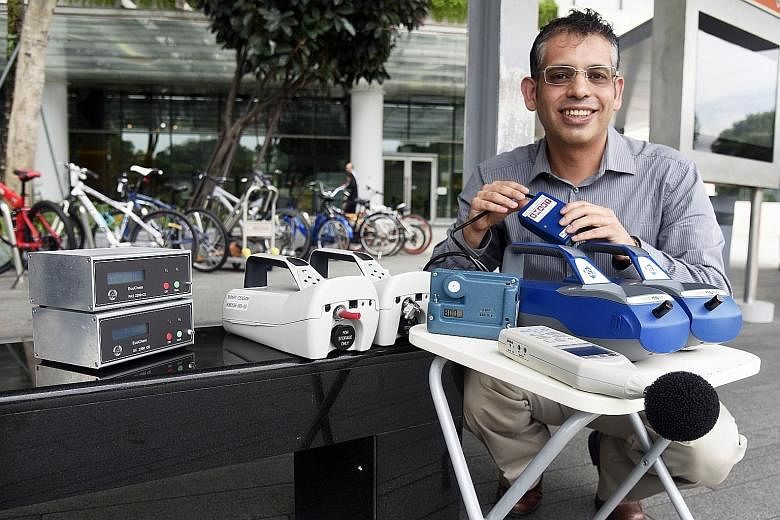Even without the haze shrouding Singapore, commuters waiting for a bus could be polluting their lungs.
The tiny particles from vehicle emissions are smaller - and more toxic - than the PM2.5 pollutants dominant during periods of haze, a new study has shown.
"Waiting at the bus stop for only 10 minutes each time may seem innocuous. But these short exposures all add up," said researcher Erik Velasco, who led the research.
-
Harm in the air
-
PM2.5
Pollutant particles which measure 2.5 microns in diameter - about a 30th the diameter of a strand of human hair. It is the dominant pollutant particle during periods of haze.
ULTRAFINE PARTICLES
These are 100 times smaller than PM2.5, and are formed when gases from vehicle tail pipes react with the air after discharge. Because they are smaller, these particles have a larger surface area that comes into contact with the human body, making them more toxic.
CIGARETTES
Smoking produces ultrafine particles full of toxic compounds. In a study a decade ago, Dr Velasco found that driving around Mexico City for an hour was equivalent to smoking 0.4 cigarettes. He said the levels detected on Mexican roads were similar to pollutant levels at Singapore's bus stops.
"A commuter who takes a two-way trip by bus to work for five days per week is actually exposed to these participles for nearly seven hours per month and over three full days per year. This exposure can affect people with existing pulmonary and cardiovascular diseases, among others."
PM2.5 are pollutant particles measuring less than 2.5 microns in diameter - about a 30th the diameter of a human hair. They are hazardous because they are small enough to be breathed into the lungs and absorbed into the bloodstream.
Dr Velasco, a research scientist from the Singapore-MIT Alliance for Research and Technology (Smart), has found that the particles commuters breathe in while waiting at a bus stop are even smaller - by about 100 times.
At a media briefing yesterday, he said a two-way bus journey five days a week could lead to a commuter inhaling about 3.5 times more tiny pollutant particles than at ambient level, which researchers measured at Fort Canning Park.
The findings were significant considering that travel on buses made up almost half of the 7.7 million public transport trips every day in 2014, said Dr Velasco, citing Land Transport Authority (LTA) data.
Dr Steve Yang, specialist in respiratory medicine and consultant at the Raffles Internal Medicine Centre at Raffles Hospital said the human body has no efficient way to remove particles smaller than 2.5 microns in diameter.
"Humans have developed ways to filter out particles 10 microns and above, which get trapped in the nose and throat and do not enter the lungs, but not the smaller particles," said Dr Yang, adding that people should not stand near idling buses.
Toxic ultrafine particles are formed when gases and particles from vehicle exhaust pipes react with each other in the air after they are discharged. Catalytic converters and filters in vehicles, while vastly improved over the years, are still unable to remove all the toxic particles and gases produced.
For the study, Dr Velasco worked with Ms Tan Sok Huang, a former National University of Singapore geography master's student to quantify pollution at five well-used bus stops in Singapore - Vivo City, Little India, Bugis, One Raffles Quay and NUS.
The researchers collected data in 2011 and 2012 using portable, state-of-the-art instruments to measure variables such as the number of ultrafine particles per unit of volume.
The study was funded by the National Research Foundation and published in science journal Atmospheric Environment last month.
In June, the LTA embarked on a six-month pilot scheme to install electric fans at five crowded bus stops in places such as Tampines and Ang Mo Kio to improve ventilation. Dr Velasco suggested that such fans, which can disperse pollutant particles and make waiting in the heat bearable, could be installed at more bus stops. He also suggested scheduling buses to arrive at specific times, to minimise waiting by commuters.
Post-graduate student Jeremy Heng, 28, who takes the MRT and bus from his home in Bukit Timah to Changi every day for a work stint, said: "I am somewhat surprised by the findings, especially about how these particles are more harmful than those in the haze.
"The broader implications of the findings emphasise that clean energy for vehicles, or a car-lite economy, is the way to go."


